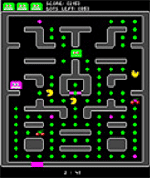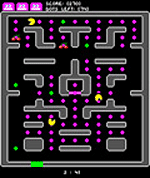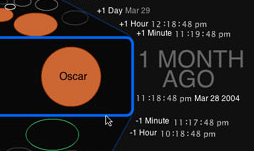June 12th, 2005
A bizarre media storm has gathered around wireless Internet cafes. Project PlaceSite and I have benefited. But this all deserves a closer look.
Tomorrow’s New York Times quotes me in an article by Glenn Fleishman. My words appeared in a Seattle Post-Intelligencer piece last week. On May 30 a Financial Times article about wi-fi in cafes mentioned “zombie effect” [definition here], a term we invented to explain some of the reasoning behind PlaceSite. All this mainstream coverage followed Web buzz about an entry by Glenn on his Wi-Fi Networking News weblog. The entry announced that a Seattle cafe had tried turning off wi-fi on the weekends.
I’m thankful for the PlaceSite publicity but for the record: each of my partners, Damon McCormick and Jon Snydal, contributed to this project at least as much as I did. Professor Marti Hearst served a critical role as our project advisor.
A problem with the coverage: The Financial Times article strongly implies a trend in cafes across the country that involves reduction or removal of wi-fi access. But the opposite is true, at least in Seattle and San Francisco: wi-fi is becoming more ubiquitous in cafes. The article cites just three cafes — one in Seattle and two in San Francisco — that have limited their wi-fi access. But hundreds of cafes in these cities offer wi-fi service, and more cafes add wi-fi every month.
I see no evidence of a new trend: both of the San Francisco cafes in question have been experimenting with limited access for more than a year.
The other articles, particularly the New York Times piece, were more balanced and better informed about this. But I sense a media snowball effect that might trigger an avalanche of inaccurate coverage.
A warning to reporters: consider the numbers here, so you don’t mistake aberrant behavior for what’s clearly the norm.
Tags: ideas, location-aware tech, wi-fi | 9 Comments »
April 16th, 2005
[ UPDATE: Our launch period at A’Cuppa Tea is over. Keep an eye on placesite.com for news of upcoming launches. ]
 We’ll launch Project PlaceSite this Tuesday
We’ll launch Project PlaceSite this Tuesday
at A’Cuppa Tea cafe and teahouse in Berkeley.
Full details: PlaceSite.com.
Come out and join in!
Tags: berkeley, ideas, location-aware tech, wi-fi | 6 Comments »
March 13th, 2005
Imagine opening your laptop computer in a neighborhood wireless Internet caf� and firing up a Web browser. Instead of your usual startup page, imagine this on your screen:
That’s the core of Project PlaceSite. It introduces a new way of using wireless networks — to create a local information service by, for and about people who are in the same caf� together.
We’re rolling it out in Berkeley in a few weeks. Details: www.placesite.com.
Please let us know what you think. And come out and take part!
Tags: berkeley, ideas, location-aware tech, wi-fi | 4 Comments »
March 11th, 2005
Most of the buzz about mobile phone video strikes me as pathetic. Who wants to watch a feature-length movie on a 1-inch screen? This is yet another example of giant corporations losing touch with their customers and trying to force old media paradigms onto new media.
My classmate Patrick Riley is building an application for video on mobile phones that actually makes sense. Why not let fans view instant replays on demand as they watch a sporting event live, in the stadium?
Bravo Patrick, mREPLAY is a great idea. It uses mobile phone video to do something suited to mobile phones, something useful that other forms of video can’t do.
Tags: ideas | 1 Comment »
February 7th, 2005
Lars Holmquist spoke of “PacMan Must Die” at Intel’s Berkeley research lablet Friday.
This is an innovative game developed by Holmquist’s students at the Viktoria Institute’s Future Applications Lab in G–teborg, Sweden. It’s a tweaked-out multi-player version of the classic game Pac Man, with two major twists.
The first twist: characters’ roles are switched. Players control ghosts invading Pac Man’s home turf, trying to recover the dots stolen by Pac Man in the original game.
The second twist: the playing field is distributed across two or more devices held by multiple players.
To finish a level, a player must eat dots not just on her own screen, but on the other players’ screens as well. If you send your ghost through a doorway on the bottom of your screen, the ghost disappears from your device. It enters another player’s screen through a corresponding doorway. The game allows up to five players to join in on the distributed fun.
Players have to look over at one another’s screens to see where to guide their characters. Physical strategy and cooperation become central to this virtual game. Opportunities for new sorts of pranks arise — for instance, you can physically run off with your friend’s ghost.
I love this; it’s another way of combining video game fun with the fun of play in real-world places.
This is the sort of rich, simple innovation that I hoped would emerge with the wi-fi enabled Nintendo DS portable video game system. But Nintendo seems to have locked down DS development, limiting it to internal and professional developers. Such professionals have years of experience and training in building traditional games. This background cripples their ability to innovate, to see beyond the constraints of traditional game platforms.
Nintendo, learn from eBay and Google and Amazon: let customers and outsiders build value for you. Open your platform and let it thrive.
Tags: ideas, location-aware tech, wi-fi | 8 Comments »
October 20th, 2004
Why not use wi-fi (wireless Internet) access points to track down stolen cars, bikes, purses and other valuables?
Many of Earth’s major cities are becoming saturated with wi-fi access points. It’s hard to find a public place in San Francisco, for instance, where a wi-fi device can’t detect a nearby access point.
Imagine placing a narrow wi-fi beacon device inside the frame of your bicycle. You tell the beacon that, every day at 4 a.m., the bike is locked up at your house. Next time the clock strikes 4 a.m., the beacon turns itself on and it makes note of which wi-fi access points it can “see” from your home. It remembers that these access points represent home. Then it turns itself off again. (Wi-fi detection drains a lot of battery power — the device stays off most of the time to save juice).
Two days later, at precisely 4 a.m., the beacon powers on and notes what access points it can “see.” If it detects one or more of the “home” access points, it turns itself off again. Two days later it does the same thing, and so on. We’ll call this state of affairs the beacon’s default mode.
During one of these early-morning access-point checks, if the device doesn’t detect a home access point, it switches into “stolen mode.” It powers on every 15 minutes and checks for any open access points. (Open access points are not encrypted, so anyone — and in our case, any beacon — can use them to connect to the Internet.)
Read the rest of this entry »
Tags: ideas, location-aware tech, wi-fi | 25 Comments »
October 19th, 2004
I avoid blindly posting links to other sites from cheesebikini because this doesn’t add much value to the Web. But this one is just too perfect: A new product called TV-B-Gone is a tiny universal remote control that turns off almost any television. Walk into a bar or restaurant or gym, press the button and the device sends out 209 different codes to turn off TVs, the most popular brands first.
More from Wired News, from NPR and from the manufacturer (whose site is currently offline).
But what happens when TV manufacturers create new “off” codes? It would be great to be able to periodically update the device with code lists downloaded from the Web, in the same way you update virus-scanning software. Perhaps in the next version…
(Thanks Jeff!)
Tags: ideas | 8 Comments »
October 8th, 2004
 Look for unplanned potential within the Nintendo DS, an upcoming handheld videogame system. It uses wi-fi, as well as a proprietary Nintendo wireless format, to let a player compete and communicate with another in the same room, or with a potentially infinite number of other players via connections to the Internet through wi-fi hotspots. The New York Times says the unit will go on sale in the U.S. November 21 for $149.
Look for unplanned potential within the Nintendo DS, an upcoming handheld videogame system. It uses wi-fi, as well as a proprietary Nintendo wireless format, to let a player compete and communicate with another in the same room, or with a potentially infinite number of other players via connections to the Internet through wi-fi hotspots. The New York Times says the unit will go on sale in the U.S. November 21 for $149.
Nintendo’s marketing, the press, and the weblogs all seem fixated on the fact that this unit has two screens, and the fact that it will let people play the same old types of multiplayer games in mobile settings.
But I think a special combination of attributes make this a potential source of compelling new smartmobbish applications and behavior:
(1) Not only does it provide wireless networking capabilities, it’s built around using wi-fi in an ad-hoc person-to-person manner — regardless of whether wi-fi hotspots are nearby.
(2) When an open wi-fi hotspot is nearby, it can be used to connect from the field with servers on the Internet.
(3) Kids will use it, and kids aren’t locked into narrow wireless communication paradigms.
(4) It’s not too expensive, which might encourage a critical mass of these things in urban areas. (Compare it with Sony’s upcoming $300+ wi-fi-enabled PSP game device.)
Imagine the sociolocative fun that this might enable — if Nintendo doesn’t block out nonlicensed developers.
(Thanks to Matthew Rothenberg for the tip!)
Tags: ideas, location-aware tech, wi-fi | 4 Comments »
June 24th, 2004
Our Chief Los Angeles Correspondent Kathy Valladares discovered the newest bulletproof business trend to hit California: underground strip health clubs.
In each of the three union-owned-and-operated Lusty Lady Sport Clubs, rows of exercise equipment are interspersed between raised stages and brass poles. Direct cash tipping is forbidden. In aggregate the dancers are paid at least as much as they would earn at a traditional strip club, but their pay is built into the (quite expensive) gym membership fees. A computer system monitors each customer’s fitness progress on a second-by-second basis, and rewards the currently-performing dancers based on the customers’ exercise performance.
Scenario: Lazy Dave has trouble dragging himself into the gym, and even more trouble carrying through on a full, vigorous workout once he gets there. Dave starts his workout with cardio, hopping on a stationary bike. If he slacks off during Bubbles’ dance (if his speed and heart rate drop too low) Bubbles’ pay during that dance falls accordingly. But if Bubbles can encourage Dave to reach and maintain his peak level of biking exertion during her dance, a big pay bonus is automatically deposited into her account. How Bubbles manages this — by taking off her clothes or keeping them on, by dancing near Dave when he does well or turning away when he slacks off — is determined by the two; the important thing is that Bubbles and Dave are both incentivized to get Dave into shape.
An ambient disco-ball feedback system informs the strippers how close each patron is to his or her peak level of effort, second-by-second. Mirrored disco balls suspended above each piece of exercise equipment tell the tale: slow-spinning mirror-balls indicate slacking patrons and fast spins suggest healthy levels of exertion.
And you thought Pilates was hot…
Tags: ideas | 5 Comments »
 We’ll launch Project PlaceSite this Tuesday
We’ll launch Project PlaceSite this Tuesday




 Look for unplanned potential within the
Look for unplanned potential within the 